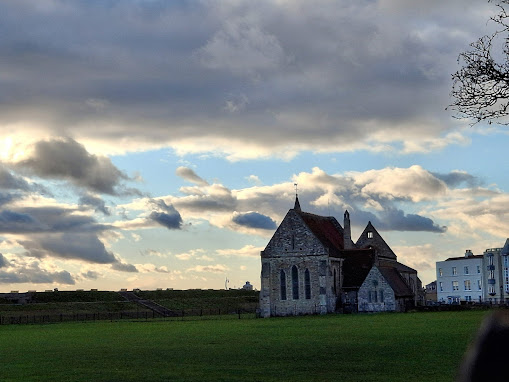Thursday 19th December 2024.
Pembroke Road, Old Portsmouth.
It was damn cold today with a fresh north-westerly blowing across Old Portsmouth and remained for the rest of the day. On the positive side, it was bright and sunny with a bit of high cloud, but the couple of hours I was there this morning and afternoon, I thought my finger tips were going to drop off! Yesterday, there were a total of 14 species seen and today, I got up to 15 bird species in all during both shifts in Pembroke Road. Most of the usual birds were seen, including the noisy Jays and a pair of Brent Geese put in an appearance too as they flew eastbound to join their compatriots. Greenfinches had been seen both today and yesterday, which included a flock of 6 birds yesterday.
Highland Road Cemetery, Southsea:
After doing a few chores around the house, I wanted to not waste the bright weather and so took the dogs for a walk around Highland Road Cemetery. Again, the chilly north-westerly wind blew through the Cemetery, keeping the temperatures down to around 8 degrees, though it felt more like 3 degrees!
It was quiet at first and eventually, the birds started to appear or be heard. It was not till I reached the south-east side that a Great Spotted Woodpecker was heard calling somewhere further north. Unfortunately, I never saw the bird as by the time I got up to the north-east corner, the bird had flown. There was no sign of the Green Woodpecker today either, but a male Sparrowhawk showed well briefly, flying low over the gravestones over on the east side and I think it landed out of sight within a tall Conifer. Two male Greenfinches were in one of the trees in the north-east corner, before flying off northbound over the houses. This species has suffered a sharp decline due to infections, so it is good to see these birds around here. Pied Wagtails never settle in the Cemetery and it is always good to see one on my travels here, though they are always a flyover. My final notable bird was a Goldcrest, which was heard and then seen flying out of a Conifer in the middle of the Cemy.
Due to recent storms, I noticed a lot of branches down on the floor, though I suppose it is good for the trees to lose their deadwood; as long as it doesn't drop on my head when I am walking around! Very few dog-walkers today here and so less disturbance for the wildlife here. The only plants I found flowering today were Smooth Sow-thistle; though these were few and far between.
The birds seen or heard this morning included the following:
- Herring Gull
- Wood Pigeon
- Feral Pigeon
- Blue Tit
- Great Spotted Woodpecker
- Sparrowhawk (male)
- Greenfinch
- Wren
- Blackbird
- Starling
- Magpie
- Carrion Crow
- Pied Wagtail
- Goldcrest
In Hampshire today, the showy Black-throated Diver was still showing to the small crowd gathered by the Town Mill Pond in Emsworth for its second day (or possibly third?). See below. A staggering 32 Spoonbills were on Normandy Marshes and up to 3 female type Scaup were on Milton Lakes. 15 Cattle Egrets were found in the fields at Northney, Hayling Island and Great Northern Divers were in Portsmouth Harbour and Langstone Harbour.
Some excellent news today was of the completion of the repairs to the Sluice Gate on Farlington Marshes. Though this is great news, it is a temporary arrangement and hopefully soon will be fully completed. However, the damage done by the sea water could be irreparable due to the fact that the main reedbed on the Lagoon has been destroyed. Whether it will grow back remains to be seen, but the dependency of nesting birds and also the insects within the reeds will be lost for some time. Maybe the waders will come back to roost during high tide; something we all birders and wildlife enthusiasts hope and pray for.














No comments:
Post a Comment